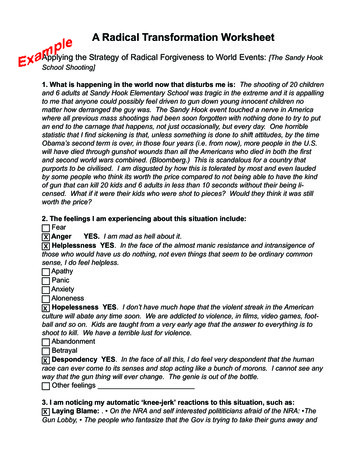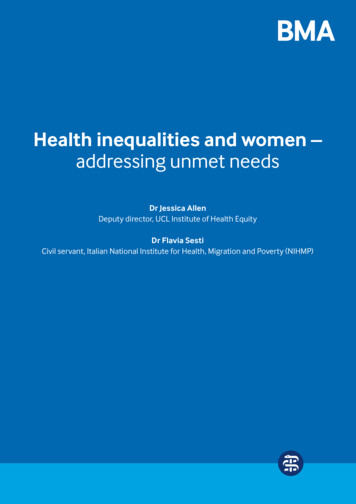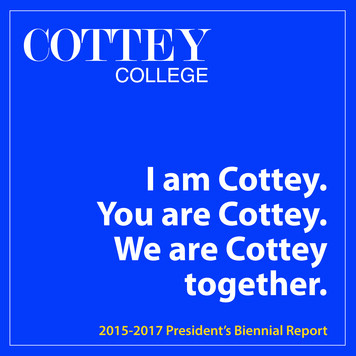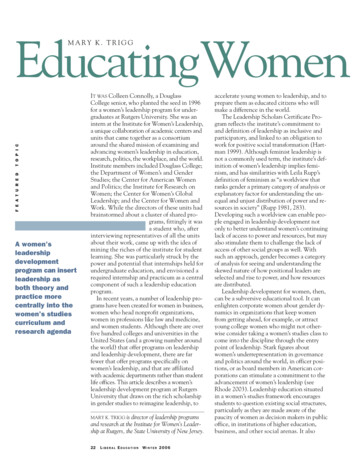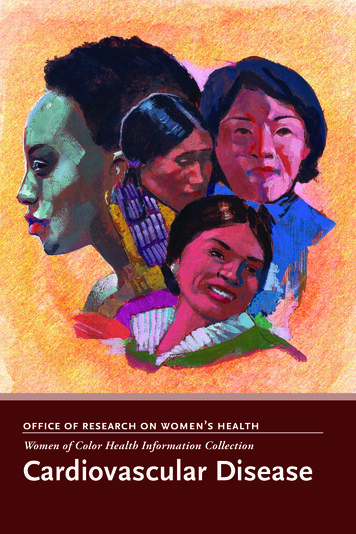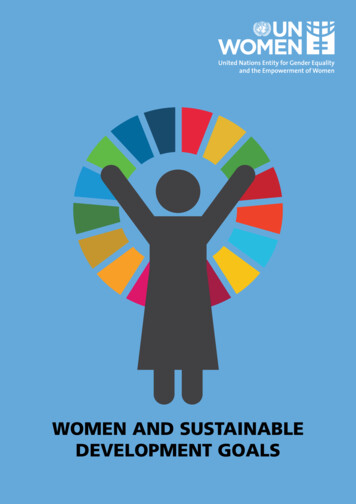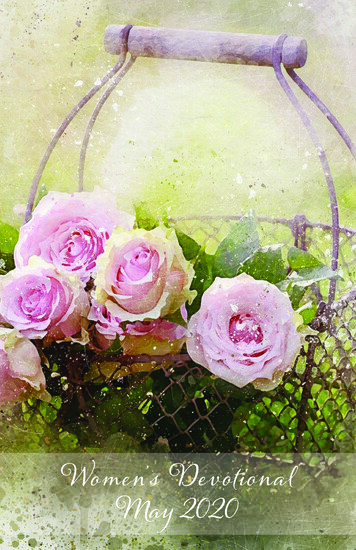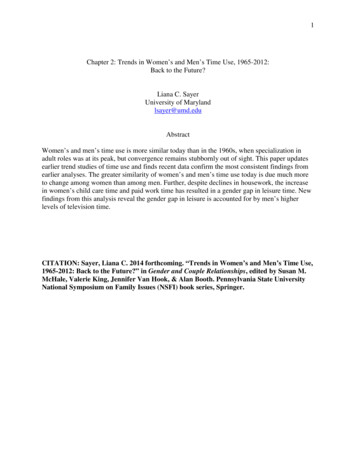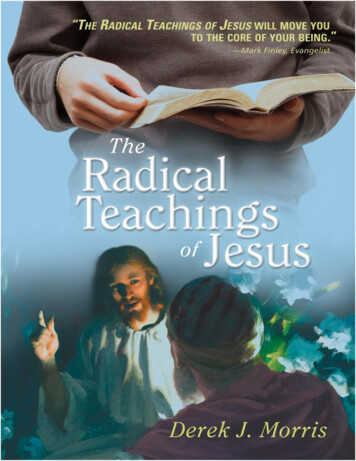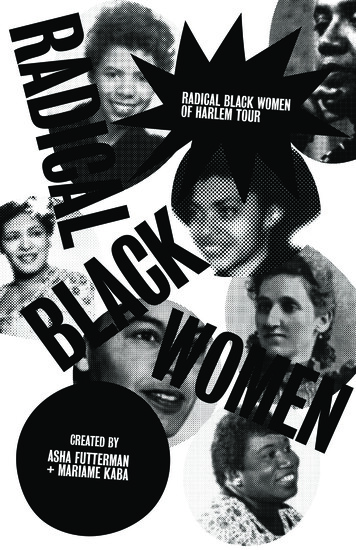
Transcription
LRADICARADICAL BLACK WOMENOF HARLEM TOURKCALB WOMENCREATED BYASHA FUTTERMAN MARIAME KABA
RADICAL BLACK WOMEN OF HARLEM TOURCREATED BYAsha FuttermanMariame KabaMAPPED BYArrianna PlaneyDESIGNED BYNeta Bomani
W 135 STHARLEMELLA BAKER, RESIDENCEKEAVCHOLASFNILAUGICVDBLSSDOERREDWHITE ROSE MISSIONBILLIE HOLIDAY, HOME AT AGE 15AUDRE LORDE, FAMILY HOMENEW YORK AMSTERDAM NEWSHARLEM WORKERS SCHOOLLENOX AVERADICAL BLACK WOMENOF HARLEM TOURMAPHARLEM HOSPITALAMY ASHWOOD GARVEY, RESIDENCEWALKER HOMETHE W 137TH STREET BRANCH YWCAAMY ASHWOOD GARVEY, LIBERTY HALLHURSTON'S NIGGERATI MANORREGINA ANDERSON ANDREWS, DREAM HAVEN7TH AVEE 135 ST
KEY TOUR STOP7TH AVELENOX AVE5TH AVESTESRI, HERE, GARMIN, OPENSTREETMAPCONTRIBUTORS, AND THE GIS COMMUNITYHE 130TLINCOLN HOUSESSPEAKERSʼ CORNER ON 135TH STREETHARLEM BRANCH LIBRARYHURSTON RESIDENCELIBERATION BOOKSTOREHARLEM WORKERS SCHOOL, LOCATION 2CLAUDIA JONESE 139TH ST
RADICAL BLACK WOMEN OF HARLEMTenant’s League focused on howpoor housing led to disproportionately high death rates amongBlack residents and mobilizedhundreds of Black women in theHarlem community. From 1933 to1934, Burroughs ran the HarlemWorker’s School. In 1934, Burroughs ran for Lieutenant Governor of New York with communistparty organizer Israel Amter. Although she and Amter didn’t win,they received more votes than anyother communist leader has everreceived in a gubernatorial election. She died in 1945.WILLIANA JONES BURROUGHS200 WEST 135TH ST415 LENOX AVEWilliana Jones Burroughs (18821945) was a Black Communistleader. She was born in 1882 toa formerly enslaved woman inPetersburg, Virginia and movedto Manhattan when she was fiveyears old. After she graduatedfrom Hunter College, Burroughsstarted a teaching career thatled her into the world of BlackHarlem intellectuals and elites,and introduced her to communism.She joined the New York Teachers’Union and wrote for the DailyWorker and organized within theCommunist Party around the “NegroQuestion.” In 1928, Burroughs waschosen as one of two Black communist leaders to go to Moscow toattend Communist International’s(Comintern) Sixth Congress. Shealso worked with Louise ThompsonPatterson on the campaign fordefense of the Scottsboro Boys,and organized within the Harlem community with the HarlemTenant’s League. The Harlem6REGINA ANDERSON ANDREWS103-105 WEST 135TH ST580 ST. NICHOLAS AVERegina Anderson Andrews (19011993), born in Chicago in 1901,defied the stereotypical imageof the bookish, spinster librarian. In addition to being alibrarian, Andrews was a radicalactivist, playwright, and entertainer. Regina began working as alibrarian in the Chicago PublicLibrary system making up halfof one percent of Black librarians in the U.S. When she moved
A WALKING TOURto New York, she worked at the135th Street Harlem branch of theNew York Public Library system(NYPL), which was the only branchthat hired Black librarians. Atthe Harlem Branch, Andrews setaside workspace for famous Blackwriters, like Langston Hughes andClaude McKay. Andrews also developed a theatre in the basementof the Harlem Library Branch andco-founded the Krigwa Playerswith W.E.B. Du Bois. The Krigwa Players, later known as theNegro Experimental Theatre, was agroundbreaking theatre company,instrumental to the Little Theatre Movement in Harlem. Andrewswent on to to become the firstBlack supervising librarian atthe previously all-white, 115thStreet branch of the NYPL.ELLA BAKER103-105 WEST 135TH ST452 NICHOLAS AVEIn 1960, Ella Baker (1903-1986)called for a student conference to organize the spontaneoussit-ins spreading throughout theSouth. Those who gathered formedthe Student Nonviolent Coordinat-ing Committee (SNCC); Baker wasboth the organization’s mentorand its fervent supporter. Toher, it was “crystal clear thatthe current sit-ins and other demonstrations are concernedwith something bigger than ahamburger. The Negro and whitestudents, north and South, areseeking to rid America of thescourge of racial segregationand discrimination – not only atthe lunch counters but in everyaspect of life.” Baker served asdirector of branches of the NAACPand as the first executive director of the Southern ChristianLeadership Conference (SCLC). Asan advisor to SNCC, she helpedto organize voter registrationprojects and was pivotal informing the Mississippi FreedomDemocratic Party in 1964. Bakerbelieved in democratic, grassroots activism that stressed therole of many ordinary people,not of individual leaders. Shelived this philosophy, inspiringa generation of young people inthe civil rights movement to dothe same.CLAUDIA JONESSPEAKERS’ CORNER ON 135TH STREETBorn in Trinidad, ClaudiaCumberbatch Jones’s (1915-1965)family immigrated to New Yorkwhen she was just nine yearsold. In Harlem, Jones’s familylived in poverty, and her motherdied working an un-unionizedfactory job when Claudia was7
RADICAL BLACK WOMEN OF HARLEMjust 12 years old. The ScottsboroBoys case drew Jones’s attention to the work of the CommunistParty USA. At 18, Jones joinedthe Young Communist League andquickly rose through the ranksof the Harlem Communist Partyto become one of the few Blackwomen leaders in the Party. Joneswrote in the Daily Worker aboutthe struggles of poor Black life.For instance, she wrote a column titled “Half of the World,”which tackled what the communistparty called “the woman question.” Jones’s most cited work isher essay titled “An End to theNeglect of the Problems of NegroWomen,” which was published inPolitical Affairs in June 1949.In the essay, Jones suggestedthat Black women experience triple discrimination as workers, asBlack people, and as women. Joneswas sent to prison four times forbeing a member of the communistparty and for her writings. InDecember 1955, she was deportedto London. While in London, shefounded the West Indian Gazetteand started a carnival at NottingHill which millions of BritishCaribbeans attend every year tothis day. Jones died at the ageof 49 from a heart attack stemming from her lifelong strugglewith tuberculosis. She is buriedin Highgate Cemetery to the leftof Karl Marx.Lorraine Hansberry was bornand raised on the South Side ofChicago. She moved to New Yorkin 1950 to study under W.E.B. DuBois, who said Hansberry was hisfavorite student. In New York,Hansberry published a few8 poems and wrote for a lesbi-LORRAINE HANSBERRYSPEAKERS’ CORNER ON 135TH STREETan journal. While she did write,Hansberry was mainly a full-timeactivist. She was known for giving speeches at speakers cornerand was an active organizer andprotester. In 1951, Hansberrycovered and participated in agathering billed as a “Sojournfor Truth and Justice.” A groupof 14 Black women leaders issued“a call to Negro women to convenein Washington, D.C. for a Sojourn for Truth and Justice.” Themanifesto was a response to thewave of repression that they wereliving under. The conveners wereconcerned about many issues including racial terrorism (lynchings, police violence, wrongfulconvictions, etc.) and endingthe Korean war, colonialism,South African apartheid, poverty,and more. Later, after marryingRobert B. Nemiroff, who gave herspace and financial support towrite, Hansberry wrote A Raisinin the Sun and became the firstBlack woman to produce a show onBroadway. After Raisin, Hansberry
A WALKING TOURwrote two other plays. Althoughshe was married to Nemiroff formost of her adult life, Hansberry self-identified as a lesbian,wrote about homosexuality, andhad many women partners in herlifetime. She died of cancer at34 years old.She supervised white nurses andtreated Spanish civilians andwounded volunteers of all nationalities. When she returned to theU.S. in May 1938, she went on anational speaking tour about herexperiences in Spain. She died inAkron, Ohio on May 18, 1990.MADAME C.J. WALKER108-110 WEST 136TH STREETSALARIA KEEHARLEM HOSPITAL ON 506 LENOX AVEBorn in Milledgeville, Georgiain July 1917, Salaria Kee (19171990) grew up to become “the mostprominent black woman in theinternational campaign to defendRepublican Spain (p.104, McDuffie).” In 1933, Kee led a demonstration against segregationistpolicies at the Harlem Hospitalwith five other Black nurses. Heractivism continued when Italy conquered Ethiopia in 1935.Kee worked with a group of Blacknurses at Harlem Hospital toraise funds for medical suppliesfor Ethiopia. In March 1937, at23 years old, she traveled toSpain where she met with Blackvolunteers from the U.S., theCaribbean, and Africa. Kee wasappointed by the InternationalMedical Unit as the head surgicalnurse in a hospital near Madrid.Madame C.J. Walker (1867-1919)was born Sarah Breedlove inDelta, Louisiana in 1867. Shewas raised on farms in Deltaand in Mississippi, was marriedby age 14, and was widowed at20. Walker went on to become asuccessful hair and cosmeticsentrepreneur – and, by the early20th century, the richest selfmade woman in America. Walker sawher personal wealth not as anend in itself but as a means tohelp promote and expand economicopportunities for others, especially Black people. She tookgreat pride in the profitableemployment – and alternative todomestic labor – that her companyafforded many thousands of Blackwomen who worked as commissionedsales agents. Walker also waswell known for her philanthropy,supporting Black educational andsocial institutions from the national to the grassroots levels.9
RADICAL BLACK WOMEN OF HARLEMA’LELIA WALKER108-110 WEST 136TH STREETA’Lelia Walker (1885-1931) wasthe only child of Madame C.J.Walker and hosted one of the mostmemorable salons of the HarlemRenaissance. In “The Dark Tower,”a converted floor of her New Yorktownhouse, she entertained Harlemand Greenwich Village writers,artists, and musicians, as wellas visiting African and Europeanroyalty. Her parties, along withher regal beauty, lavish clothing, and glamorous lifestyle,inspired singers, poets, andsculptors. Langston Hughes calledher the “joy goddess of Harlem’s1920s”; Zora Neale Hurston outlined a play about her and hermother; and Carl Van Vechtenbased his Nigger Heaven character, Adora Boniface, on her.A’Lelia helped her mother foundthe Madame C.J. Walker Manufacturing Company in 1905, thenopened its New York office andbeauty salon in 1913. Upon Madame C.J. Walker’s death in 1919,A’Lelia Walker became presidentof the company. Her interest inAfrica led her in 1922 to becomeone of the only westerners tovisit Ethiopian Empress WaizeruZauditu.10VICTORIA EARLE MATTHEWS262 WEST 136TH STREETVictoria Earle Matthews (18611907) was born in Fort Valley,Georgia to an enslaved mother.After Emancipation, Victoria’smother moved her family to NewYork. In New York, Matthews wrotestories about her childhood whichwere published in New York Weekly, Waverly magazine, and otherperiodicals. Matthews became afreelance journalist writing fornumerous newspapers, includingthe New York Times, the New YorkHerald, the New York Globe, andlater became a journalist for theNew York Age, a respected Blacknewspaper. Matthews also published a novel, Aunt Lindy, undera pseudonym. In 1892, Matthewsorganized an event to honor andfundraise for Ida B. Wells’s anti-lynching efforts. Matthews’sevent raised money for Wells’spamphlet, “Southern Horror: LynchLaw in All Its Phases.” Wellscalled the event “the greatestdemonstration ever attempted byrace women for one of their ownnumber.” In 1897, after Matthews’s only son died at 16,Matthews founded the White RoseMission with the purpose of establishing a Christian “Home for
A WALKING TOURColored Girls and Women, wherethey may be trained in the principles of practical self-help andright living.” Matthews died oftuberculosis in 1907 at the ageof 45. In 1918, the White RoseHome and Industrial Associationfor Working Girls and Women movedto 136th Street in Harlem, whereit remained in operation until1984.ogist, Hurston became a believerin voodoo. In the 1930s, Hurstonmade two trips to Haiti and Jamaica. She died poor and mostlyerased, buried in an unmarkedgrave. It was writer Alice Walkerwho brought her books back fromobscurity and put a tombstone onher gravesite that read “ZoraNeale Hurston: A Genius of theSouth.”ZORA NEALE HURSTON267 WEST 136TH STREETA writer in the Harlem Renaissance during the 1920s, ZoraNeale Hurston (1891-1960) was themost prolific Black woman writerof her time. Born in Eatonville,Florida (the first incorporatedall-Black township in the U.S.),Hurston was the daughter of aminister and school teacher. Shewrote numerous short stories forliterary magazines before entering Barnard College in NewYork as its first Black student.Hurston graduated in 1928 andthen continued to work in graduate school at Columbia with thefamous anthropologist, FranzBoas. Over the next 30 years, sheproduced eight novels and threecompilations of short stories,all reflecting her interest inanthropology and women’s issues.Her best-known work, Their EyesWere Watching God, is a fictionalautobiography. A noted anthropol-LOUISE THOMPSON PATTERSON267 WEST 136TH STREETBorn in 1901 in Chicago, LouiseThompson Patterson (1901-1999)moved often as a child. Pattersonlater was one of the first Blackwomen graduates of UC Berkeley,and after graduation, followedW.E.B. Du Bois and LangstonHughes to Harlem. In Harlem,Patterson helped Hughes and ZoraNeale Hurston prepare theirwriting for publishing, mentoredRalph Ellison, worked with theInternational Labor Defense andthe Civil Rights Congress, andjoined the Communist Party USA(CPUSA). Patterson became a fullfledged organizer in the CPUSAthrough the Scottsboro trials.She was the main organizerof a high-profile protest in11
RADICAL BLACK WOMEN OF HARLEMsupport of the “Scottsboro Boys”(nine Black boys who were falselyaccused in Alabama of raping twowhite women on a train in 1931).Locking arms with Ruby Bates,one of the white women who hadfalsely accused the boys of rape,Patterson marched along with5,000 others toward the WhiteHouse demanding the freedom ofthe Scottsboro Boys and others.During the 1930s, Patterson wasa member of communist-sponsoredgroups such as the League ofStruggle for Negro Rights, theInternational Worker’s Order, andthe International Labor Defense.These groups confronted issuesthat affected the daily lives ofBlack workers, poor people, andmore. For instance, they addressed evictions, provided food,and led hundreds of marches andstrikes. Patterson was 50 yearsold when she served as the executive secretary of Sojournersfor Truth and Justice. She was acultural worker, an organizer, afeminist, a committed internationalist, and a revolutionarywho traveled to the Soviet Unionand around the globe.Born in Richmond, Virginiain 1912, Dorothy Height (19122010) grew up in Pennsylvaniaand later studied social work atNew York and Columbia Universities. She was initially accepted to Barnard College but whenshe arrived there, she was toldthat the school already had twoBlack students and was deniedadmission. In 1937, as assistant director of the Harlem YWCA,Height assisted Eleanor Rooseveltat a meeting of the National12 Council of Negro Women (NCNW)DOROTHY HEIGHT175-179 WEST 137TH STTHE W 137TH STREET BRANCH YWCAand was spotted by NCNW president Mary McLeod Bethune. Twentyyears later, Height became president of the NCNW. A veteran civilrights campaigner and organizer,Height also shaped national andinternational policy regardingthe rights of women – first inthe early 1960s as a member ofPresident Kennedy’s Commission onthe Status of Women, and over theyears in United Nations forums onwomen’s political and economicissues. Height was a human rightsactivist and organizer in localto international arenas for morethan 50 years, and devoted herlife to marshaling the creativeenergies of Black women for theirown empowerment.The first Black woman to beordained as an Episcopal priest,Pauli Murray (1910-1985), spentmuch of her activist life helpingto dismantle barriers of racialand gender discrimination. “Ientered law school preoccupiedwith the racial struggle and single-mindedly bent upon becoming acivil rights lawyer but I graduated an unabashed feminist as
A WALKING TOURPAULI MURRAY175-179 WEST 137TH STTHE W 137TH STREET BRANCH YWCAwell,” Murray said in 1956.She often attributed her fighting spirit to her upbringing in aMidwestern working-class familythat put a premium on education,character, and upward mobility. From integrating Washington,D.C. lunch counters in the 1940sduring her law school days atHoward University through herco-founding of the National Organization for Women in the early1970s, Murray took challengeshead-on. In discussing sexism atHoward, she said, “The only wayI could counter it was to leadmy class. Which I did. For threeyears.” She went on to teach atseveral universities and compilea massive reference work on staterace laws. In her later years,Murray turned her energies to thespiritual, attending the VirginiaTheological Seminary and servingas an Episcopal priest in Baltimore.Amy Ashwood Garvey (1897-1969)was born in Port Antonio, Jamaica in 1897. She co-foundedthe Universal Negro ImprovementAssociation and African Communi-ties League (UNIA), the largestand most influential Pan-Africanorganization of the 20th century.Garvey served as general secretary of the organization, fundraised relentlessly, and helpedpopularize The Negro World newspaper.While Garvey was fiercely dedicated to the Pan-African cause,she also was disappointed withthe roles that women were allowedto play in the UNIA. She left NewYork in 1922 and moved to London,where she opened a restaurant inthe West End which became a gathering spot for people like GeorgePadmore, C.L.R. James, and JomoKenyatta.AMY ASHWOOD GARVEY552 MALCOLM X BLVDLIBERTY HALL ON 120 WEST 138TH STREETWhen Garvey returned to theU.S. in 1944, she became activein the campaign to elect AdamClayton Powell, Jr. to Congress.In 1945, she co-chaired, alongside W.E.B. Du Bois, the openingsessions of the Fifth Pan-African Conference in Manchester,England. Garvey lived in WestAfrica from 1946-1949 andwas involved in the anti-co13
RADICAL BLACK WOMEN OF HARLEMlonial struggle. For the restof her life, she split her timeamong England, the Caribbean,West Africa, and the U.S. Overtime, Garvey became more vocal inaddressing women’s issues. In thelate 1950s, she organized a community center in London and wasactive in the aftermath of theNotting Hill race riots of 1958.Garvey died in Jamaica in 1969.BILLIE HOLIDAY108 WEST 139TH ST151 W 140TH STBillie Holiday (1915-1959) wasborn Elenora Fagan in Philadelphia on April 7, 1915. Early inher life, Holiday worked cleaning homes and running errandsfor a brothel. At 15, she movedto Harlem with her mother. Herfirst singing job was in a clubin Jungle Alley on 133rd Street,and she made her recording debut in 1933. In the late 1930s,Holiday was recording with Columbia records. It was then thatshe began to sing Strange Fruit,which she continued to sing for20 years. Immediately after shesang Strange Fruit in front ofa mixed-race audience, she received her first threat from14 the Federal Bureau of Narcot-ics. After this, several undercover FBI agents were sent totrack Holiday’s every move, andshe was sent to prison in 1947for possession of narcotics. Shewas released a year later, butnot allowed to sing at any jazzclubs that sold alcohol (everyjazz club in the U.S.). Still,she performed a sold-out concertat Carnegie Hall and recordedsome of her biggest hits aroundthis time. Though the FBI constantly tracked Holiday becauseof her activism, she refused tobe silent on issues of racism.After she was put on trial for athird time, many singers were tooscared to sing Strange Fruit inpublic. In 1959, when she was 44years old, Holiday became verysick and was hospitalized due toliver disease. While hospitalized, the FBI confiscated all ofHoliday’s belongings. Holiday wasnot given proper medicine whenshe was in the hospital and –while protestors marched outsidethe hospital chanting “Let LadyLive” – she died surrounded byFBI agents and penniless as a result of consistently being cheated out of her earnings. Holiday’smusic genius and legacy continueto influence American culture andinspire jazz singers.Born in Harlem to West Indian parents on February 18, 1934,Audre Lorde (1934-1992) beganwriting poetry when she was inhigh school. She earned a Master’s Degree in Library Scienceat Columbia University and workedas a librarian while raising herchildren. In 1968, while a poet-in-residence at Tougaloo College – a historic Black college
A WALKING TOURAUDRE LORDE108 WEST 142ND STin Mississippi where the campuswas under siege by white peoplewho routinely shot at or arrestedstudents for non-crimes – Lorderealized she wanted to use poetryas a weapon against social andpolitical forces that assailedmarginalized members of society. “I realized I could take myart in the realist way and makeit do what I wanted,” she said,“altering feelings and lives.”Lorde held teaching posts atmultiple universities, was namedNew York State Poet Laureate, andco-founded with Barbara Smith andCherrie Moraga Kitchen Table:Women of Color Press in Harlem.MADAME STEPHANIE ST. CLAIR117 W 141ST STMadame Stephanie St. Clair(1897-1969) may have been bornin Guadeloupe and may have been13 or 23 years old when she arrived at Ellis Island in 1913.Soon after her arrival, St. Clairworked as a numbers runner in anillegal gambling ring. In 1923,with 10,000 in savings, shelaunched her own “policy bank” –even though in the 1920s, Blackpeople owned less than 20% ofHarlem’s businesses. St. Clairfunded community projects, employed hundreds of people, loanedmoney to those who needed it, andmore. She became known in Harlemas “Queenie” and was one of thelargest policy bankers in Harlem.In the 1920s and 1930s, MadameQueenie’s power and wealth couldnot be underestimated. She earnedover 200,000 a year and employedhundreds of people. St. Clair washeavily surveilled and harassedby police even though she paidbribes to keep them at bay. Aftershe was imprisoned, St. Clairdecided to go to war against thepolice and others. She took outads in the Amsterdam News andother Black newspapers callingout corrupt cops, white mobsters,and even some politicians. St.Clair also wrote a column in theAmsterdam News where she wouldoffer “Know Your Rights” adviceto her fellow black Harlemites.She married Harlem activist SufiAbdul Hamid and was accused ofshooting him in 1938. He survived the shooting, and St. Clairmaintained that the gun went offaccidentally during a strugglebetween them. There is no information about how long she wasincarcerated in prison or whenshe was released. St. Clair isthought to have died in NewYork in 1969.15
RADICAL BLACK WOMEN OF HARLEMditions, Cooke quit and startedworking at the Daily Compass in1950. Cooke was the first Blackand first woman reporter at theDaily Compass. After two years ofworking at the Daily Compass, sheshifted her focus toward organizing. Cooke served as treasurer for the Angela Davis DefenseCommittee, raising thousandsof dollars and organizing massinternational support to releaseDavis from prison. She also headed the New York Council of Artsand was national vice chairman ofthe National Council for Soviet-American Friendship.MARVEL COOKE2293 ADAM CLAYTON POWELL JR. BLVDBorn in Minneapolis in 1903,Marvel Cooke (1903-2000) leftfor Harlem in the 1920s to become a writer. She came to Harlem to work as a journalistat Crisis. Cooke lived at 409Edgecombe, “The White House ofHarlem,” where she lived nearother Black intellectuals, writers, and artists such as FaithRinggold, Thurgood Marshall, andRoy Wilkins. After Crisis, Cookebecame the first woman journalist at the Amsterdam News. Sheis most famous for publishing afive-part series in the AmsterdamNews with Ella Baker titled “TheBronx Slave Market.” Cooke was amember of the communist party,well known by the FBI as a highly connected communist and wellknown in her community as a communist recruiter. Much of Cooke’sjournalistic work reflects herrelentless pursuit to exposeexploitation of Black workers inHarlem. After striking at theAmsterdam News in an effortto gain better working con-16ESLANDA GOODE ROBESON250 SEVENTH AVE – NEAR 133RD STREETBorn in Washington, D.C. inDecember 1895, Eslanda CardozoGoode (1895-1965)—or Essie, asshe was more commonly known—movedto New York City with her familyas a young girl after the deathof her father. She studied atboth the University of Illinoisand Columbia University and wasawarded a B.S. in chemistry in1923. She met Paul Robeson whileliving in Harlem and married him
A WALKING TOURin 1921. After years of workingat New York-Presbyterian Hospital, Essie became the first Blackperson to hold the position ofhead histological chemist of surgical pathology.Essie also took on the role ofher husband’s manager and promoter. She was a shrewd businessperson and a zealous advocatefor Robeson’s talent. Later, shestudied anthropology and becamea prolific writer and pan-Africanist thinker. Essie advocated for women’s rights and was acommitted anti-colonialist. Shetraveled the world alone and withher husband, with a particularinterest in Africa. Essie wouldco-found the Council on AfricanAffairs and the Sojourners forTruth and Justice.Mulzac moved to Guyana (thenknown as British Guiana) to starta bookstore and to work for theparty of Cheddi Jagan, a revolutionary Marxist. One day a package arrived at the bookstore andexploded when a colleague openedit, killing him. Mulzac sufferedwounds to an eye and her chest.She moved back to the U.S. in1966 and opened Liberation Bookstore – the legendary bookstorethat existed on West 131st Streetfor 40 years. Liberation Bookstore was an important communitymeeting center for authors, militants, and activists.GRACE CAMPBELLLAFAYETTE HALL ON 131 STREET AND 7TH AVEUNA MULZAC421 MALCOLM X BOULEVARDUna Mulzac (1923-2012) was bornin 1923 in Baltimore and moved tothe Bedford-Stuyvesant section ofBrooklyn as a little girl. Aftergraduating from high school, shegot a secretarial job at RandomHouse, where she became interested in publishing. Around 1963,Grace Campbell (1882-1943) wasborn to Jamaican immigrants inGeorgia in 1882, and she moved toNew York in 1905. Campbell was acommunity organizer in Harlem,leading the Harlem Tenants Leaguewith Williana Burroughs. Campbell founded the 21st branch ofthe Socialist Party and was thefirst Black person to jointhe Socialist Party. In 191917
RADICAL BLACK WOMEN OF HARLEMand 1920, she ran for office inthe New York State Assembly onthe Socialist ticket. Althoughshe did not win the election,Campbell received 10 percent ofthe vote. Later, she moved awayfrom the Socialist Party andfounded the African Blood Brotherhood (ABB) with Cycil Briggs.The ABB was founded as a responseto racism in the Communist Party USA. While many communists inthe U.S. attempted to forg racistexploitation, the ABB believedthat racism was the root causeof capitalist exploitation andcentered the “Negro Question.” Inthe 1920s, Campbell joined theCommunist Workers’ Party in theU.S. She was tracked by the FBIfor most of her life, but she remained involved in communism andactivism until she died in 1943.WILLIE MAE MALLORYLINCOLN HOUSES ON 2110 MADISON AVEWillie Mae Mallory (1927-2007)was born in Macon, Georgia in1927. She moved to New York Citywith her mother in 1939 and livedin Harlem. Mae Mallory played anintegral role in the Black18 freedom movement in the U.S.Mallory organized with variousleftist organizations (includingbriefly with the Communist Party). In 1957, she sued the NewYork Board of Education challenging their zoning policies, whichshe argued forced Black childrento stay in inferior schools.Mallory became the spokespersonof the group that became known asthe Harlem 9. The Harlem 9 demanded an “open transfer” policythat would allow them to sendtheir children to schools outside of their district and alsowould allow community controlof Harlem schools through parent associations. Before therewas a FREE ANGELA or FREE ASSATA campaign, there was a FREEMAE MALLORY campaign. In August1961, Mallory fled from NorthCarolina to Ohio in fear for herlife. She and journalist JulianMayfield had visited Black radical Robert Williams and hisfamily in Monroe, North Carolina. During that visit, Williamswas falsely accused of kidnapping an elderly white KKK couple,Mr. and Mrs. Bruce Stegall. As aresult of these (false) chargesof kidnapping, Mallory and theother Monroe Defendants faced aharsh prison sentence and yearsof legal troubles. While she wasincarcerated at Cuyahoga CountyJail, Mallory wrote letters andshared her thoughts about theexperience. Mallory died in 2007at the age of 80. She is buriedin an unmarked grave in the Frederick Douglass Memorial Park onStaten Island.
A WALKING TOURBACKRGOUNDHARLEM, NEW YORKHarlem is both an idea and aplace. What became known as the“Black Mecca” began as a farmingvillage inhabited first by theLenape and then by the Dutch. Thefirst Black people in Harlem,both freed and enslaved, workedon farms in the area known asNieuw Haarlem. Nieuw Haarlem wasformally established as a settlement by Peter Stuyvesant in 1658and was named after the Dutchcity of Haarlem. For generations,the sole connection between NieuwHaarlem and Nieuw Amsterdam wasa diagonal road built on an oldNative path: a street we now callBroadway.Once railroad lines made itto Harlem, more people began tobuild and settle in the community. A subway line completed in1904 made Harlem more accessible to people living in southernparts of New York City. In theearly 1900s, crowds started tovisit Harlem for entertainment,visiting local theaters, clubs,and speakeasies.In 1904, Philip A. Payton, Jr.founded the Afro-American Realty Company and launched a driveto bring Black people to Harlem.He used outdoor billboards toadvertise and also put ads inelevated and subway trains. InDecember 1905, a New York Heraldheadline announced “Negroes MoveInto Harlem.” The article pointedout that “[d]uring
librarian, Andrews was a radical activist, playwright, and enter-tainer. Regina began working as a librarian in the Chicago Public Library system making up half of one percent of Black librar-ians in the U.S. When she moved 103-105 WEST 135TH ST 580 ST. NICHOLAS AVE REGINA ANDERSON
